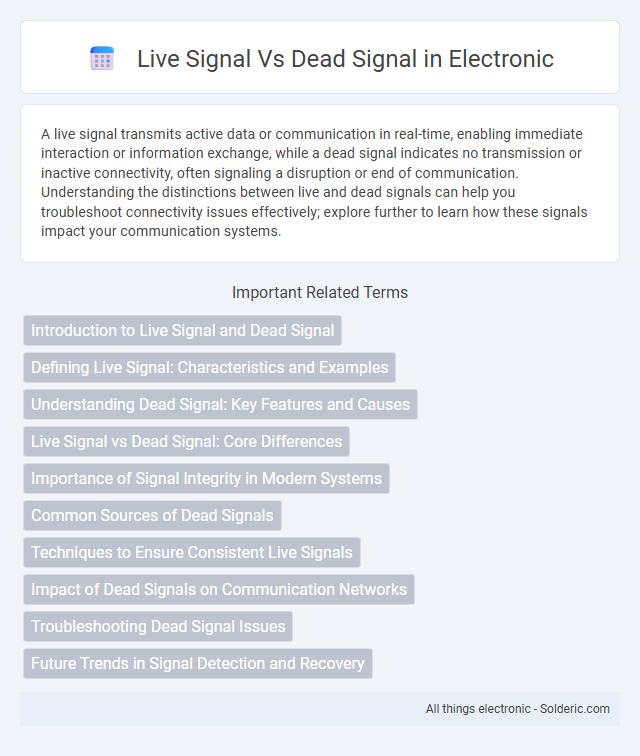A live signal transmits active data or communication in real-time, enabling immediate interaction or information exchange, while a dead signal indicates no transmission or inactive connectivity, often signaling a disruption or end of communication. Understanding the distinctions between live and dead signals can help you troubleshoot connectivity issues effectively; explore further to learn how these signals impact your communication systems.
Comparison Table
| Aspect | Live Signal | Dead Signal |
|---|---|---|
| Definition | Active electrical signal carrying data or power | Inactive or non-functional signal with no data or power |
| Status | On, transmitting | Off, no transmission |
| Usage | Real-time communication, data transfer | Faulty circuits, disconnected lines |
| Detection | Measured by signal meters, oscilloscopes | Detected by absence of voltage or current |
| Risk | Potential electric shock | No electric shock risk |
| Example | Live power cable, active data cable | Cut wire, disconnected signal line |
Introduction to Live Signal and Dead Signal
Live signal refers to real-time broadcast transmissions carrying current audio, video, or data streams, enabling immediate consumption and interaction. Dead signal describes a transmission that has ceased, resulting in no active data or content being transmitted over a communication channel. Understanding the distinction is crucial for effective monitoring and troubleshooting in broadcast and telecommunications systems.
Defining Live Signal: Characteristics and Examples
A live signal refers to an active electrical current or transmission carrying real-time data, such as a live broadcast, active Wi-Fi, or a powered circuit in electronics. Key characteristics include continuous transmission, real-time responsiveness, and the presence of measurable voltage or frequency indicating an active state. Understanding if your signal is live often involves using tools like multimeters or spectrum analyzers to detect these dynamic, operational signals.
Understanding Dead Signal: Key Features and Causes
Dead signal refers to a communication or broadcast signal that no longer transmits usable data, resulting in loss of connection or service interruption. Key features include absence of audio or video, static noise, or a continuous blank screen, indicating complete signal failure. Understanding the causes, such as hardware malfunction, environmental interference, or service provider outages, helps you diagnose and restore live signal functionality effectively.
Live Signal vs Dead Signal: Core Differences
Live signal transmits real-time data or communication, enabling immediate interaction or response, while dead signal refers to inactive or non-functional transmissions with no current data flow. Live signal maintains continuous connectivity and dynamic updates, essential for applications like broadcasting and live streaming. Understanding these core differences helps you optimize system performance by identifying and addressing dead signal issues promptly.
Importance of Signal Integrity in Modern Systems
Signal integrity is crucial in modern systems to ensure accurate data transmission and prevent errors caused by live signals carrying dynamic data versus dead signals that represent static states. Maintaining high-quality signal integrity reduces noise, crosstalk, and signal degradation, which are essential for reliable communication in high-speed digital circuits. Your system's performance and longevity depend on preserving clear and stable live signals while minimizing the impact of dead signals on overall signal clarity.
Common Sources of Dead Signals
Common sources of dead signals include damaged cables, faulty connectors, and interference from electronic devices. Weather conditions such as heavy rain or storms can also disrupt signal transmission. Ensuring your equipment is properly maintained and free from physical damage helps prevent dead signals and maintain a strong live signal.
Techniques to Ensure Consistent Live Signals
Techniques to ensure consistent live signals include robust encoding methods such as adaptive bitrate streaming, which dynamically adjusts video quality based on real-time network conditions. Implementing redundancy protocols like Forward Error Correction (FEC) and Real-Time Transport Protocol (RTP) retransmissions minimizes packet loss and maintains signal integrity. Network optimization strategies, including low-latency content delivery networks (CDNs) and jitter buffers, further stabilize live stream transmission by reducing delays and smoothing data flow.
Impact of Dead Signals on Communication Networks
Dead signals disrupt communication networks by causing data loss and increased latency, which degrades overall network performance. These inactive or unresponsive signals consume bandwidth and processing resources without contributing to meaningful communication, leading to inefficiency. Understanding the impact of dead signals helps you optimize network traffic and maintain robust connectivity.
Troubleshooting Dead Signal Issues
Dead signal issues often stem from faulty cables, incorrect input settings, or hardware malfunctions within your device. To troubleshoot, first verify all connections are secure and test cables for damage or wear. Adjust input sources on your device and perform a reset or power cycle to restore signal integrity.
Future Trends in Signal Detection and Recovery
Future trends in signal detection and recovery emphasize the integration of artificial intelligence and machine learning to enhance live signal optimization and dead signal restoration. Advances in real-time data analytics and adaptive filtering algorithms enable more accurate identification and reconstruction of weak or corrupted signals across telecommunications and broadcasting networks. Emerging technologies like 5G and edge computing further support dynamic signal recovery processes, reducing latency and improving overall communication reliability.
live signal vs dead signal Infographic

 solderic.com
solderic.com